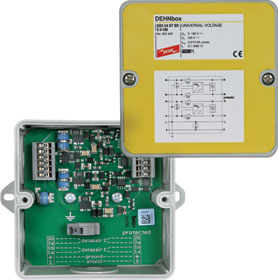Combined arrestor for telecom systems
20 May 2015
Circuit & System Protection

The arrestor has been optimised for general installation on telecommunication connections and devices such as analog telephones, ISDN and xDSL. Field tests have shown that the arrestor can even be used for high-performance VDSL2 connections.
With the DEHNbox, surges are limited to an acceptable level for the connected terminal equipment without interfering with the data signal. It can be retrofitted thanks to its surface-mounted enclosure which is ideally suited for wall mounting.
The cables lead into the enclosure via a self-sealing rubber grommet, which not only allows fast and easy installation but also prevents the penetration of moisture and dust. The cable cores (solid and flexible with wire end ferrule) and the earthing conductor can be connected by inserting them into the spring-loaded terminals of the fast connection system without tools. An additional, separate terminal allows direct connection to the cable shield of the equipotential bonding system.
The DEHNbox TC 180 protects one balanced data interface (ISDN, analog telephones, xDSL) and has a high lightning current discharge capacity of 2,5 kA (10/350 μs) per line. The arrestor can be installed in lightning protection zone boundaries from 0A to 2 and higher. Its cut-off frequency of 250 MHz ensures transmission of high-frequency signals. With its IP65 degree of protection, it can be installed in almost all environments.
For more information contact Dehn Protection South Africa, +27 (0)11 704 1487, [email protected], www.dehn-africa.com
Further reading:
Smarter protection without disruption
NewElec Pretoria
Circuit & System Protection
Designed for operations still running without integrated automation, NewElec’s retrofit-friendly systems let you upgrade performance and safety without overhauling your entire network.
Read more...
Circuit breaker for reliable, compliant protection
RS South Africa
Circuit & System Protection
Legrand’s low-voltage power distribution portfolio encompasses the DX3 range of miniature circuit breakers, designed to deliver dependable protection in residential, commercial and industrial installations.
Read more...
Reducing noise on power supply lines
Future Electronics
Circuit & System Protection
Murata has introduced the EMIFIL ESD Series Noise Filters, a breakthrough solution engineered for superior noise suppression and enhanced electrostatic discharge (ESD) protection.
Read more...
Clearing the Static: Fundamental principles of static control
Actum
Circuit & System Protection
Controlling electrostatic discharge in electronics manufacturing is essential with effective ESD programs built on six key principles.
Read more...
Electrical fire safety in lithium-ion battery rooms
Circuit & System Protection
Pratliperl is a non-combustible, ultra-lightweight aggregate that can be mixed with cement and applied as a plaster or screed to walls, floors, and ceilings.
Read more...
Clearing the Static: ESD training in the workplace
Actum
Circuit & System Protection
To protect sensitive electronic components, A structured, consistent, and sustainable ESD training program is essential.
Read more...
Protect your pumps – protect your profit
NewElec Pretoria
Circuit & System Protection
In South Africa’s demanding agricultural landscape, irrigation is not just an essential service – it is the heartbeat of farm productivity.
Read more...
Clearing the Static: ESD and installation: A durable antistatic solution
Actum
Circuit & System Protection
ESD flooring provides a reliable, long-term solution for managing static electricity by safely dissipating static charges through the floor to a designated ground point.
Read more...
Why wait to automate
NewElec Pretoria
Circuit & System Protection
NewElec’s initiative helps you gain operational visibility via HMI or PLC by retrofitting intelligent motor protection relays without replacing MCCs or rewiring the plant.
Read more...
Clearing the Static: Effectively control static in your workplace
Actum
Circuit & System Protection
Controlling electrostatic discharge in the workplace is crucial to protect sensitive electronic equipment from damage. Implementing an ESD control program involves various measures and tests.
Read more...


